How to Manage Meeting Interruptions and Distractions
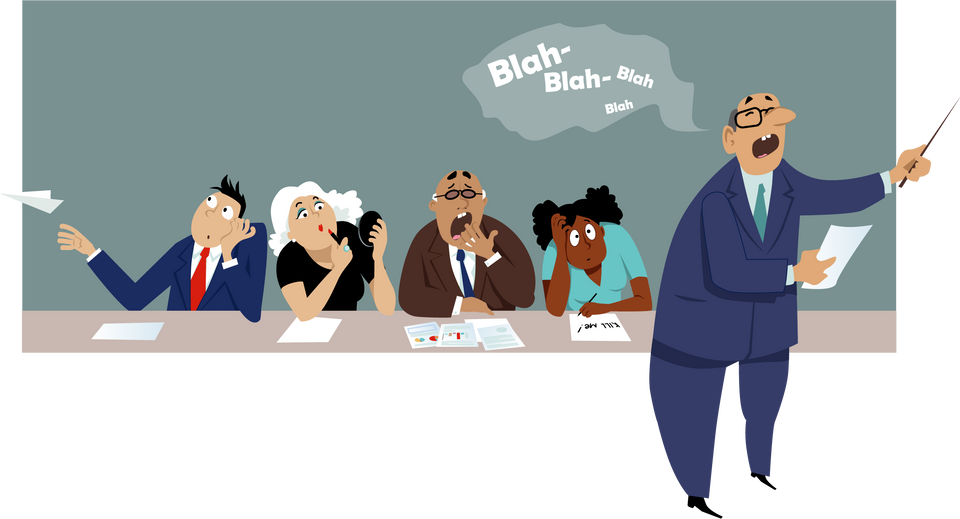
Introduction
The Importance of Managing Interruptions and Distractions in Meetings
In today's fast-paced business world, effective meetings are crucial for successful collaboration and decision-making. However, interruptions and distractions can significantly hinder a meeting's productivity and focus, leading to wasted time and resources. Effectively managing these disruptions is key to ensuring that meetings remain on track and achieve their intended outcomes.
Overview of Strategies for Managing Interruptions and Distractions
In this article, we will explore various strategies to help you manage interruptions and distractions during meetings, including:
- Understanding meeting interruptions and distractions
- Addressing common meeting interruptions
- Managing meeting distractions
- Cultivating a culture of respectful meetings
- Encouraging active participation
- Minimizing interruptions and distractions in virtual meetings
By implementing these strategies, you can create a more focused and productive meeting environment, ultimately leading to better outcomes and a more efficient use of time for all attendees.
Understanding Meeting Interruptions and Distractions
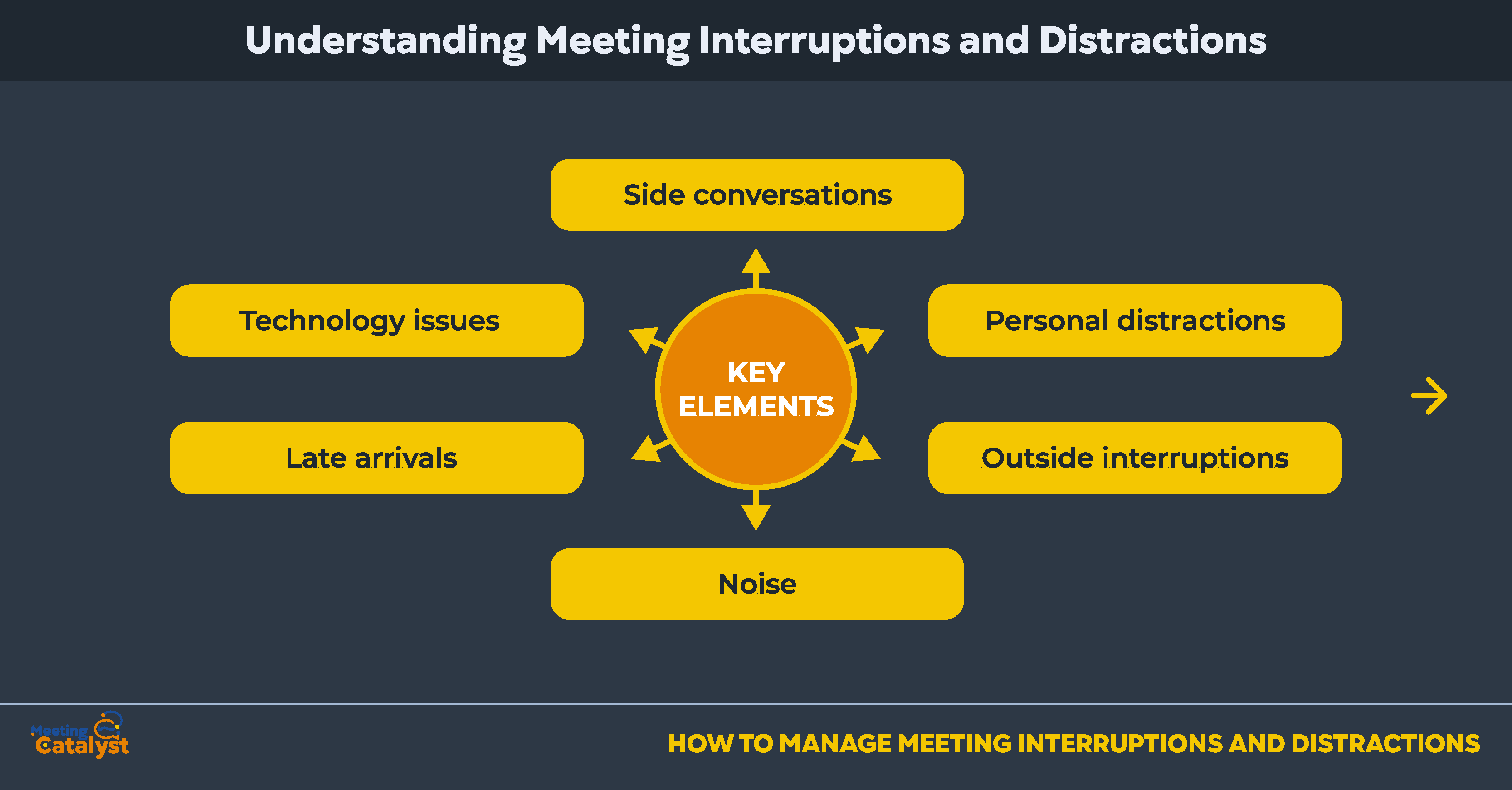
Common Types of Interruptions and Distractions
To effectively manage interruptions and distractions in meetings, it's essential to first understand the most common types that may arise. Some typical examples include:
- Side conversations
- Technology issues
- Late arrivals
- Noise
- Outside interruptions
- Personal distractions
Being aware of these potential disruptions will help you prepare for and address them proactively during your meetings.
The Negative Impact of Interruptions and Distractions on Meeting Outcomes
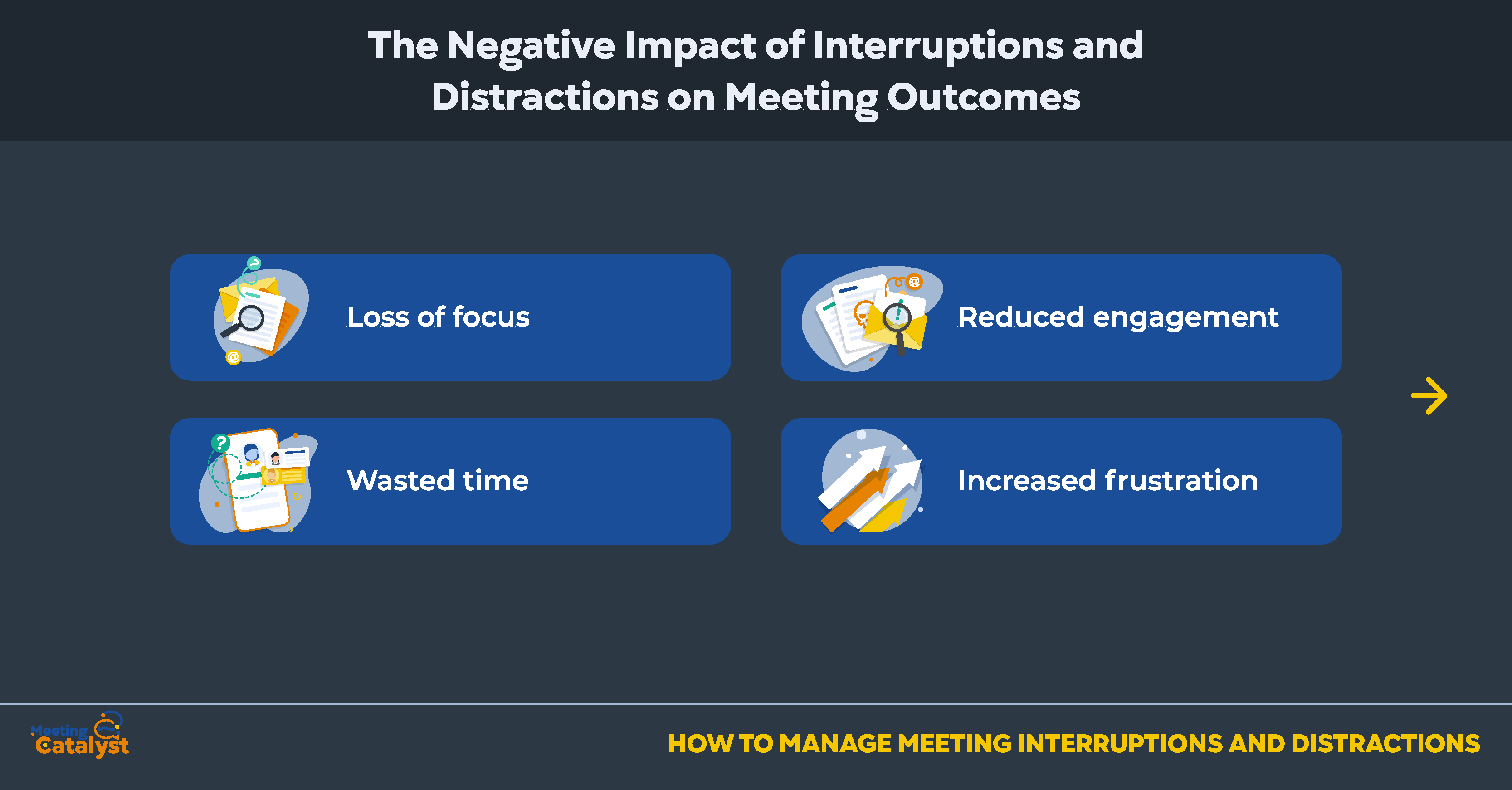
Interruptions and distractions can have a substantial negative impact on the productivity and effectiveness of meetings. Some of the consequences include:
- Loss of focus: Attendees may lose their train of thought or struggle to follow the discussion, leading to less effective decision-making.
- Wasted time: Time spent addressing interruptions and distractions can cause meetings to run over schedule, wasting valuable time for all participants.
- Reduced engagement: Frequent disruptions can cause attendees to become disengaged or disinterested in the meeting's content, leading to lower participation and collaboration.
- Increased frustration: Repeated interruptions and distractions can create a frustrating and unproductive environment, potentially causing tension among team members.
By understanding the potential impact of these disruptions, you can better appreciate the importance of managing them effectively during your meetings.
Addressing Common Meeting Interruptions
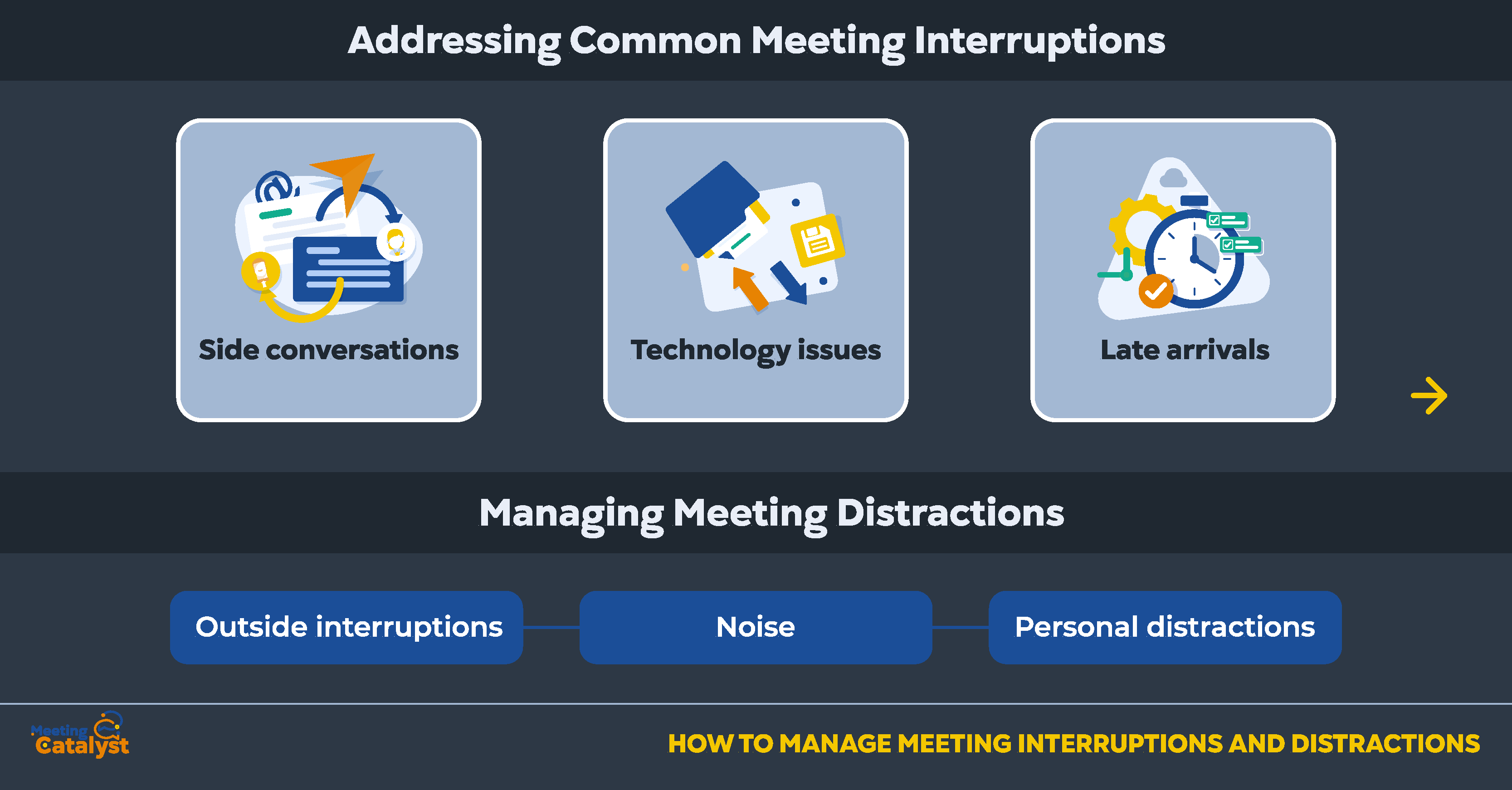
Strategies for Addressing Meeting Interruptions
Interruptions during meetings can hinder progress and waste valuable time. By implementing specific strategies, you can minimize these disruptions and maintain a productive meeting environment. Here are some approaches to address common meeting interruptions:
Side conversations: To discourage side conversations, establish clear meeting guidelines and expectations. Encourage participants to hold questions and comments until designated times, and gently remind them to stay on topic if side conversations occur.
Technology issues: Plan ahead by testing equipment and software before the meeting to avoid technical difficulties. Also, designate a tech-savvy team member to assist with any issues that may arise during the meeting.
Late arrivals: Start meetings promptly and discourage latecomers by not recapping missed content. Instead, provide meeting minutes or a recording afterward to ensure they're caught up.
By adopting these strategies, you can minimize common meeting interruptions and create a more focused, productive environment for your team.
Managing Meeting Distractions
Strategies for Managing Meeting Distractions
Aside from interruptions, distractions can also derail the productivity of a meeting. To keep your meetings on track and maintain focus, consider implementing the following strategies for managing meeting distractions:
Noise: Select a quiet meeting location, away from high-traffic areas or noisy machinery. If external noise is unavoidable, consider using noise-canceling technology or soundproofing measures to create a more conducive environment.
Outside interruptions: To minimize external disruptions, close the meeting room door, and establish a "do not disturb" policy. Ensure all participants understand the importance of staying focused and not allowing outside distractions to interfere with the meeting.
Personal distractions: Encourage team members to silence their phones and other electronic devices during the meeting. Emphasize the importance of being present and engaged, and discourage multitasking or engaging in unrelated tasks.
By taking proactive steps to manage meeting distractions, you can create a more focused and productive environment, allowing your team to make the most of their time together.
Cultivating a Culture of Respectful Meetings
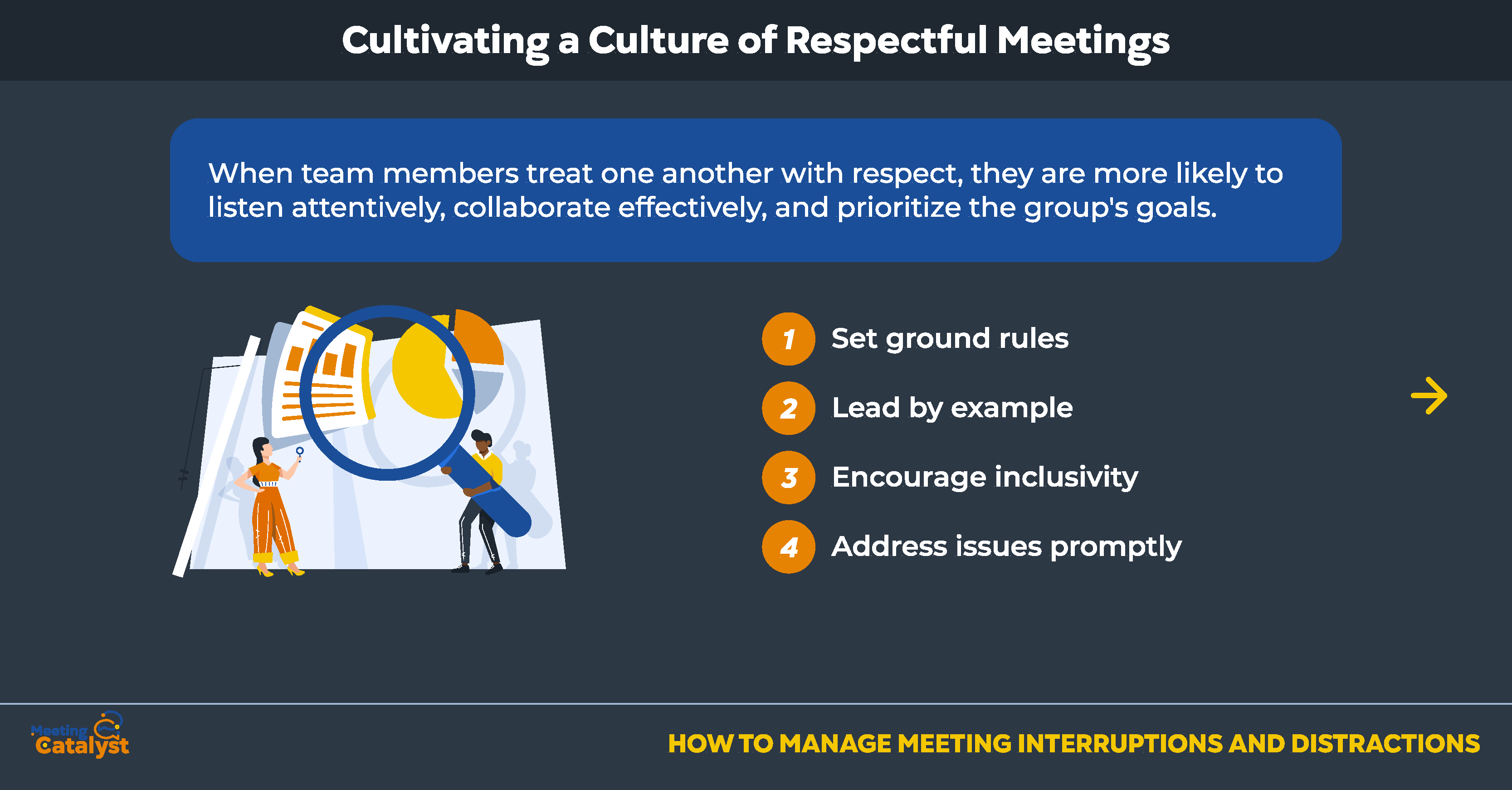
The Importance of Respect in Meetings
Fostering a culture of respect is crucial for preventing interruptions and distractions in meetings. When team members treat one another with respect, they are more likely to listen attentively, collaborate effectively, and prioritize the group's goals over their own interests.
Strategies for Cultivating a Culture of Respect
To establish a culture of respect in your meetings, consider implementing the following strategies:
Set ground rules: Establish clear expectations for meeting behavior, such as listening without interrupting, arriving on time, and being prepared. Communicate these rules to all participants and hold them accountable for adhering to them.
Lead by example: As a meeting leader, model respectful behavior by being punctual, prepared, and actively engaged. Demonstrate active listening and encourage open, honest communication.
Encourage inclusivity: Ensure all participants have an opportunity to contribute by soliciting input from quieter team members and discouraging dominant individuals from monopolizing the conversation.
Address issues promptly: If disrespectful behavior occurs, address it immediately and privately. Discuss the issue with the individual involved, emphasizing the importance of maintaining a respectful meeting environment.
By cultivating a culture of respect in your meetings, you can create an environment that minimizes interruptions and distractions, leading to more productive and efficient gatherings.
Encouraging Active Participation
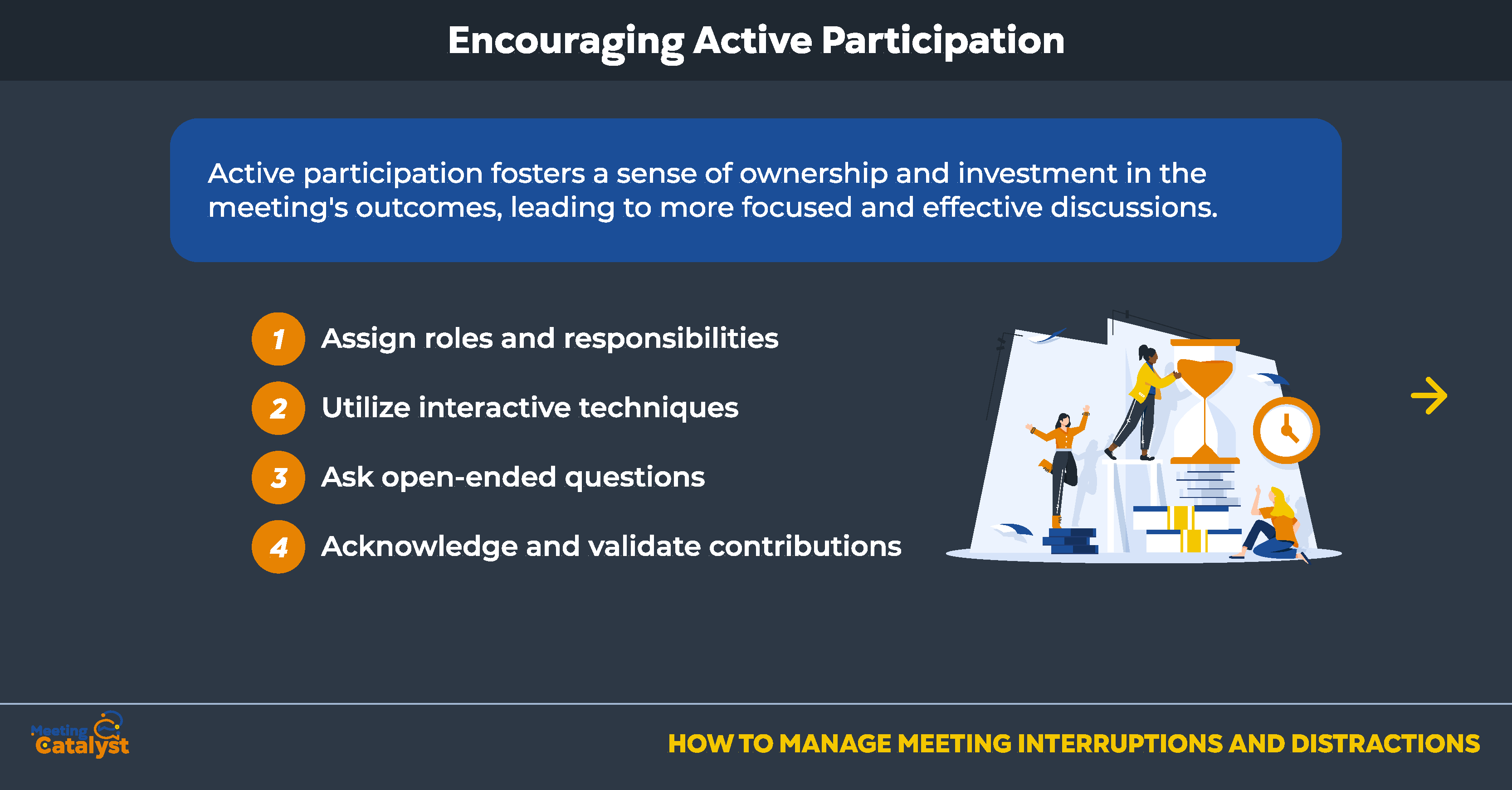
The Role of Active Participation in Reducing Interruptions and Distractions
When meeting participants are actively engaged in the conversation, they are less likely to create or succumb to interruptions and distractions. Active participation fosters a sense of ownership and investment in the meeting's outcomes, leading to more focused and effective discussions.
Strategies for Encouraging Active Participation
To promote active participation in your meetings, consider the following strategies:
Assign roles and responsibilities: Give participants specific tasks or roles, such as timekeeper, note-taker, or discussion leader. This helps create a sense of responsibility and encourages individuals to be more engaged in the meeting process.
Utilize interactive techniques: Incorporate interactive elements, like brainstorming sessions, group problem-solving activities, or breakout discussions. These techniques encourage everyone to contribute their ideas and perspectives, promoting active engagement.
Ask open-ended questions: Pose questions that require thoughtful responses, rather than simple yes/no answers. This encourages participants to think critically and share their insights, fostering more meaningful discussions.
Acknowledge and validate contributions: Show appreciation for participants' input by acknowledging their contributions and validating their ideas. This creates a positive environment that encourages further participation.
By encouraging active participation in your meetings, you can minimize interruptions and distractions, leading to more focused and efficient discussions that yield better results.
Minimizing Interruptions and Distractions in Virtual Meetings
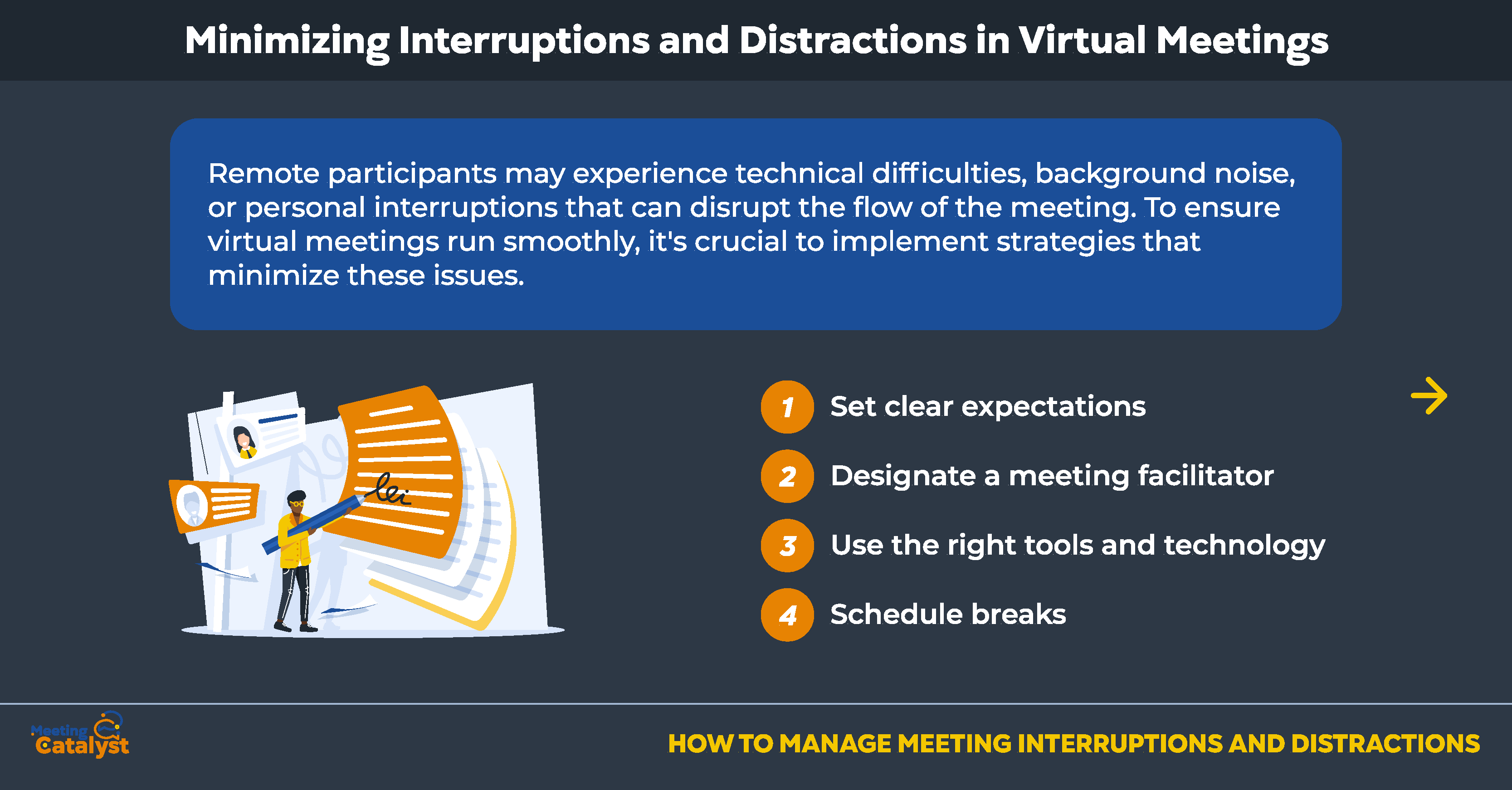
Unique Challenges of Virtual Meetings
Virtual meetings come with their own set of challenges when it comes to interruptions and distractions. Remote participants may experience technical difficulties, background noise, or personal interruptions that can disrupt the flow of the meeting. To ensure virtual meetings run smoothly, it's crucial to implement strategies that minimize these issues.
Strategies for Minimizing Interruptions and Distractions in Virtual Meetings
To reduce interruptions and distractions in your virtual meetings, consider these strategies:
Set clear expectations: Establish guidelines for virtual meeting etiquette and share them with participants in advance. This may include muting microphones when not speaking, using video when appropriate, and minimizing background noise.
Designate a meeting facilitator: Assign someone to manage the flow of the meeting, address technical issues, and ensure all participants have the opportunity to contribute. This helps maintain focus and reduce disruptions.
Use the right tools and technology: Leverage collaboration tools and platforms that offer features like noise suppression, chat functionality, and breakout rooms to minimize distractions and facilitate productive discussions.
Schedule breaks: Schedule short breaks during longer virtual meetings to allow participants to address personal needs or distractions without disrupting the meeting.
By implementing these strategies, you can minimize interruptions and distractions in your virtual meetings, leading to more focused discussions and better outcomes for your team.
Conclusion
Embracing Strategies to Manage Interruptions and Distractions
Managing interruptions and distractions is a critical aspect of ensuring effective and productive meetings. By understanding the nature of these disruptions and implementing targeted strategies, you can significantly improve the overall meeting experience for all participants.
In this article, we covered various approaches to address common meeting interruptions, manage distractions, cultivate a culture of respectful meetings, encourage active participation, and minimize issues in virtual meetings. Remember, the key to successful implementation lies in:
- Recognizing the importance of managing interruptions and distractions
- Identifying the specific challenges faced by your team or organization
- Applying appropriate strategies to address those challenges
- Continuously evaluating and refining your approach to maintain productivity and engagement
By adopting these principles, you can effectively tackle interruptions and distractions, leading to more efficient, focused, and collaborative meetings. As a result, your team will be better positioned to achieve its goals, fostering a positive work environment that prioritizes effective communication and mutual respect. Don't hesitate to start implementing these strategies in your own meetings, and watch as your team's productivity and satisfaction levels soar.